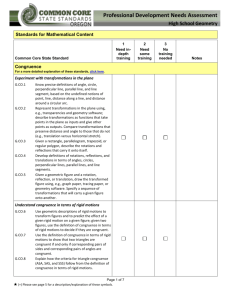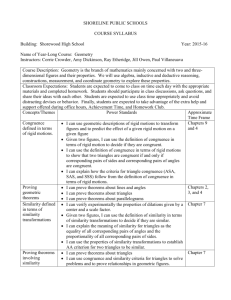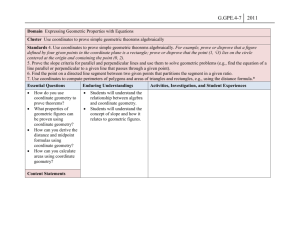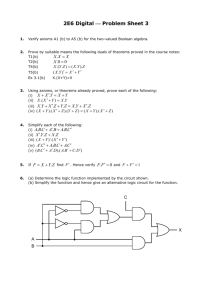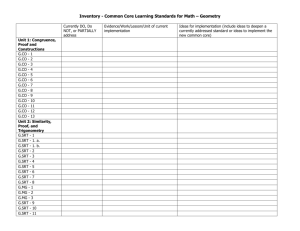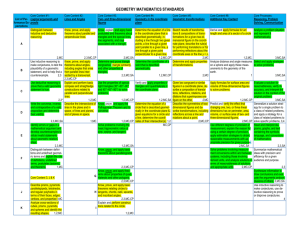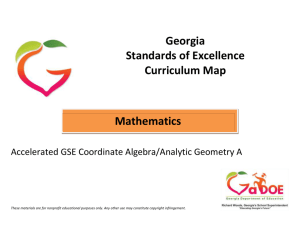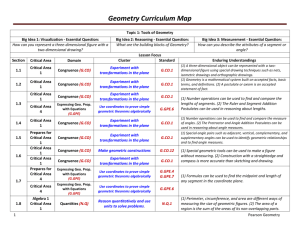Standards
advertisement
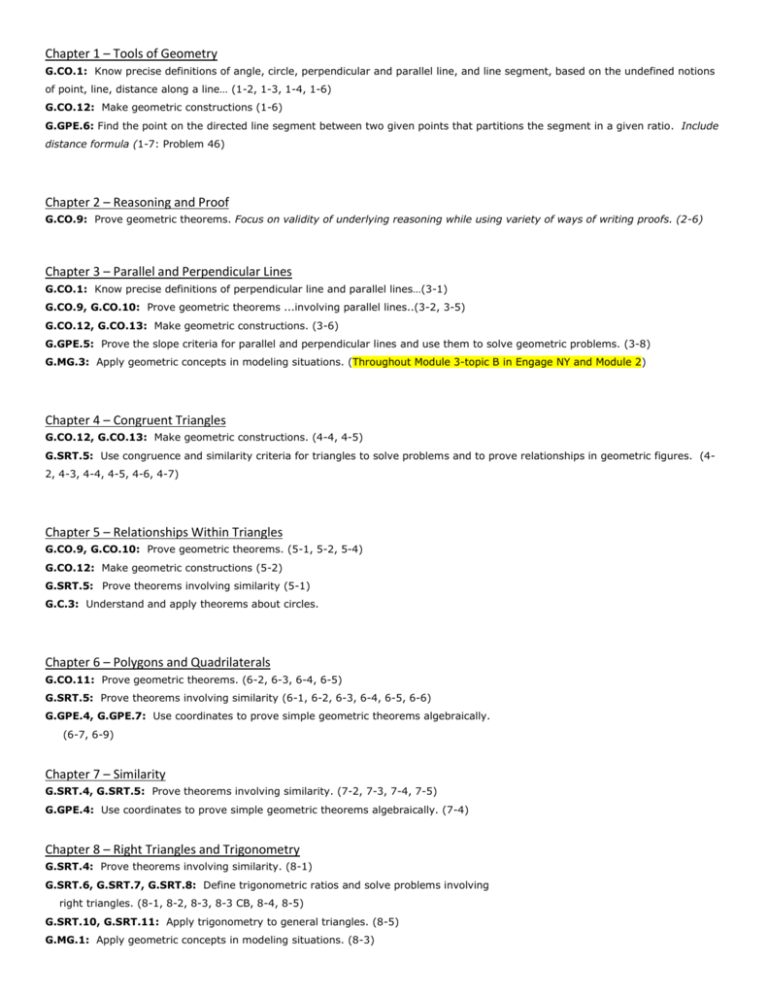
Chapter 1 – Tools of Geometry G.CO.1: Know precise definitions of angle, circle, perpendicular and parallel line, and line segment, based on the undefined notions of point, line, distance along a line… (1-2, 1-3, 1-4, 1-6) G.CO.12: Make geometric constructions (1-6) G.GPE.6: Find the point on the directed line segment between two given points that partitions the segment in a given ratio. Include distance formula (1-7: Problem 46) Chapter 2 – Reasoning and Proof G.CO.9: Prove geometric theorems. Focus on validity of underlying reasoning while using variety of ways of writing proofs. (2-6) Chapter 3 – Parallel and Perpendicular Lines G.CO.1: Know precise definitions of perpendicular line and parallel lines…(3-1) G.CO.9, G.CO.10: Prove geometric theorems ...involving parallel lines..(3-2, 3-5) G.CO.12, G.CO.13: Make geometric constructions. (3-6) G.GPE.5: Prove the slope criteria for parallel and perpendicular lines and use them to solve geometric problems. (3-8) G.MG.3: Apply geometric concepts in modeling situations. (Throughout Module 3-topic B in Engage NY and Module 2) Chapter 4 – Congruent Triangles G.CO.12, G.CO.13: Make geometric constructions. (4-4, 4-5) G.SRT.5: Use congruence and similarity criteria for triangles to solve problems and to prove relationships in geometric figures. (42, 4-3, 4-4, 4-5, 4-6, 4-7) Chapter 5 – Relationships Within Triangles G.CO.9, G.CO.10: Prove geometric theorems. (5-1, 5-2, 5-4) G.CO.12: Make geometric constructions (5-2) G.SRT.5: Prove theorems involving similarity (5-1) G.C.3: Understand and apply theorems about circles. Chapter 6 – Polygons and Quadrilaterals G.CO.11: Prove geometric theorems. (6-2, 6-3, 6-4, 6-5) G.SRT.5: Prove theorems involving similarity (6-1, 6-2, 6-3, 6-4, 6-5, 6-6) G.GPE.4, G.GPE.7: Use coordinates to prove simple geometric theorems algebraically. (6-7, 6-9) Chapter 7 – Similarity G.SRT.4, G.SRT.5: Prove theorems involving similarity. (7-2, 7-3, 7-4, 7-5) G.GPE.4: Use coordinates to prove simple geometric theorems algebraically. (7-4) Chapter 8 – Right Triangles and Trigonometry G.SRT.4: Prove theorems involving similarity. (8-1) G.SRT.6, G.SRT.7, G.SRT.8: Define trigonometric ratios and solve problems involving right triangles. (8-1, 8-2, 8-3, 8-3 CB, 8-4, 8-5) G.SRT.10, G.SRT.11: Apply trigonometry to general triangles. (8-5) G.MG.1: Apply geometric concepts in modeling situations. (8-3) Chapter 9 – Transformations G.CO.2, G.CO. 3, G.CO.4, G.CO.5: Experiment with transformations in the plane. (9-1, 9-2, 9-3, CB 9-3, 9-4, 9-6) G.CO.6, G.CO.7, G.CO.8: Understand congruence in terms of rigid motion. (9-1, 9-2, 9-3, 9-4, 9-5) G.SRT.1a, G.SRT.1b, G.SRT.2, G.SRT.3: Understand similarity in terms of similarity transformations. (9-6CB, 9-7) Chapter 10 – Area G.CO.1: Experiment with transformations in the plane. (10-6) G.CO.13: Make Geometric Constructions. (10-3) G.SRT.9: Apply trigonometry to general triangles. (10-5) G.C.1: Understand and apply theorems about circles. (10-6) G.C.5: Find arc lengths and areas of sectors of circles. (10-6, 10-7) G.GPE.7: Use coordinates to prove simple geometric theorems algebraically. (10-1) G.MG.1: Apply geometric concepts in modeling situations. (10-1, 10-2, 10-3) Chapter 11 – Surface Area and Volume G.GMD.1, G.GMD.3: Explain volume formulas and use them to solve problems (11-4, 11-5, 11-6) G.GMD.4: Visualize relationships between two-dimensional and three-dimensional objects (11-1) G.MG.1, G.MG.2: Apply geometric concepts in modeling situations. (11-2, 11-3, 11-4, 11-5, 11-6, 11-7) Chapter 12 - Circles G.C.2, G.C.3, G.C.4: Understand and apply theorems about circles. (12-2, 12-3) G.GPE.1, G.GPE.2: Translate between the geometric description and the equation for a Conic Section. (12-5, 12-5 CB) G.GMD.4: Visualize relationships between two-dimensional and three-dimensional objects. (12-16) Chapter 13 - Probability S.CP.1, S.CP.2, S.CP.3, S.CP.4, S.CP.5: Understand independence and conditional probability and use them to interpret data. (13-1, 13-2, 13-5, 13-6) S.CP.6, S.CP.7, S.CP.8, S.CP.9: Use the rules of probability to compute probabilities of compound events in a uniform probability model. (13-4, 13-6) S.MD.6, S.MD.7: Calculate expected values and use them to solve problems. (13-7)
